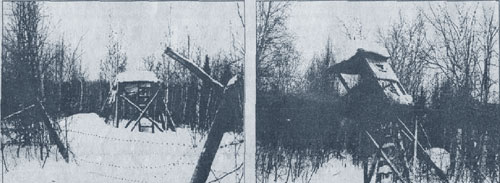









The history of our region is composed by many miscellaneos occurrences and events, including some very tragic ones, which are linked to political mass persecution. Thus, in the north of our region, they built the railway line from Salekhard to Igarka between 1948 and 1953. This was mainly done by prisoners, many of which were political inmates. The construction project was officially called: “Project N° 503 of the MVD Main Railroad Construction Administration”. Vernacularly, however, it was called differently – “The Road of Bones”.
No, formally everything looked as if they were building a completely ordinary railway line.
They fell and stubbed trees, carved hollows into the ground. They built bridges and crossovers, followed by the laying of sleepers and tracks. Apart from this, they built a motorway and installed floodlights and telegraph poles. Even a number of locomotives was delivered by barges.
Certainly, we have to consider that the entire production process took place in the impassible taiga, in a zone of a permanent frost. For that reason the people there had to cope with harsh weather conditions: cruel cold during the winter, epidemics of scurvy in the spring, the torture by swarms of biting midges in the summer and, finally, the impenetrable swamps in the autumn. And the most essential thing was that the whole plan had been determined in Moscow, in fact, without taking into consideration the special circumstances and conditions prevailing in the Arctic Circle regions. This explains the immense irreality with regard to set daily, weekly and monthly norms. The construction management was very well aware of this fact; nevertheless they issued wrong accounts and reported about labour which had remained undone.
The memoirs and public appearance of men who worked for the Road of Bones and stayed alive indicate that they were fully aware of the absurdity of their hard labour just for a few “checks’” sake.
It sometimes happened that they were forced to use sand mixed with mud, instead of gravel, for the laying of the tracks, just for the reason to be able to write a favourable account to Moscow ahead of time. Or they built bridges without anti-freeze protection (imagine this taking into account that we are talking about Siberian rivers!).
No first-class experts were needed to anticipate the deplorable ephemerality of all those abasing, hectic phantasms. Less than half a year had passed since the moment, when the laying of tracks was suspended, and the track system literally began to fall to pieces for all the world to see: bridges got broken, tracks were hovering in cavities aabove the completely sodden embankment, floodlights and telegraph posts had lost their stability and had become bent and crooked.
Nowadays, we have the possibility to look at some photos to see what has been left from forced labour camp sub-sector N° 6 right in the middle of the taiga. This was exactly the zone, where they kept those prisoners, who were directly involved in the Construction Project N° 503. The pictures were taken by Vladimir Shonin, professional photograph and inhabitant of Igarka, late in the 1980s.
Even from this photos one can recognize, how precipitately the building of the “Road of Bones” was interrupted. Everything was left in the taiga that people, by lots of pains and trouble (and enormous losses!), had delivered to the place on barges and later taken into the wild taiga, dozens of kilometers away from the riverbank. To this day we will find tracks leading to nowhere, with entirely rusted locomotives standing on them, which never used these tracks. Preserved are the half-destroyed walls of barracks, in which prisoners used to live, fragments of houses which then accomodated their supervisors, as well as watch towers and the remainders of barbed wire tight to wooden poles.

And even though the holdings of the main archive of the camp sub-sector were removed, they even found fragments of camp documents on the territory in the late 1980s. These documents, as well as numerous letters written by prisoners (they were all severed right in the middle, and you could see that censorship had torn them without opening the envelopes) were discovered by the former editor of the Igarka Newspaper – Rostislav Gorchakov. You can even find the remainders of huge camp cemeteries. There are some very last anonymous spiles you can catch sight of right in the middle of the overgrown, savaged taiga.
News
7 December 2002